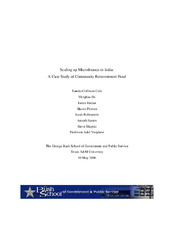Finance for Low Income Communities: Possible Applications of US Experience for India
Client
Grameen BankDescription
Much of the world's poor has difficulty in obtaining loans, especially the small loans (termed microfinance) they require. In order to improve access, Mohammed Yunus founded the Grameen Bank in Bangladesh, which uses innovative methods so the poor can obtain loans. The lessons of the Grameen Bank have been replicated worldwide, including in India in 2004 with Grameen Capital India (GCI). GCI partners with commercial banks such as the largest Indian private bank, ICICI bank, and Citigroup in order to provide funds to microfinance institutions. It structures its financial products so that low-income producers can access capital markets through various initiatives. GCI wants to expand this effort because only 5 % of Indian microfinance demand is now being met but is concerned that expanding is difficult. They believe they can learn much from an organization that has successfully increased its scale.A parallel organization in the U.S. is the Community Reinvestment Fund (CRF, crfusa.com). The CRF provides economic development funds and acts as a secondary market for loans for affordable housing and community facilities. Founded in 1989, with lending institutions in 22 states, the CRF has more experience than GCI in expanding operations. Students in this capstone project interacted with members from both the CRF and GCI and applied the lessons of the CRF to the GCI. They provided valuable advice to GCI on how it can enhance financial assistance for very small entrepreneurs in India, especially housing finance.
In this endeavor, students became familiar with one of the most popular of development fields. They actively engaged in current discussions on financial development in India and enhanced their own analytical skills in the fields of economics and finance.
Collections
Citation
Coffman-Cole, Sandra; Du, Minghua; Hattan, Justin; Powers, Shawn; Rubenstein, Sarah; Santos, Araceli; Slupski, Steve (2006). Finance for Low Income Communities: Possible Applications of US Experience for India. Available electronically from https : / /hdl .handle .net /1969 .1 /97038.


